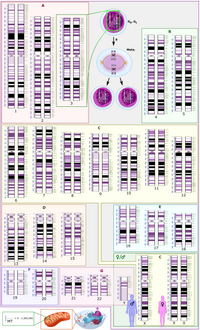
Photo from wikipedia
Circular RNAs (circRNAs) are one category of non‐coding RNAs that do not possess 5′ caps and 3′ free ends. Instead, they are derived in closed circle forms from pre‐mRNAs by… Click to show full abstract
Circular RNAs (circRNAs) are one category of non‐coding RNAs that do not possess 5′ caps and 3′ free ends. Instead, they are derived in closed circle forms from pre‐mRNAs by a non‐canonical splicing mechanism named “back‐splicing.” CircRNAs were discovered four decades ago, initially called “scrambled exons.” Compared to linear RNAs, the expression levels of circRNAs are considerably lower, and it is challenging to identify circRNAs specifically. Thus, the biological relevance of circRNAs has been underappreciated until the advancement of next generation sequencing (NGS) technology. The biological insights of circRNAs, such as their tissue‐specific expression patterns, biogenesis factors, and functional effects in complex diseases, namely human cancers, have been extensively explored in the last decade. With the invention of the third generation sequencing (TGS) with longer sequencing reads and newly designed strategies to characterize full‐length circRNAs, the panorama of circRNAs in human complex diseases could be further unveiled. In this review, we first introduce the history of circular RNA detection. Next, we describe widely adopted NGS‐based methods and the recently established TGS‐based approaches capable of characterizing circRNAs in full‐length. We then summarize data resources and representative circRNA functional studies related to human complex diseases. In the last section, we reviewed computational tools and discuss the potential advantages of utilizing advanced sequencing approaches to a functional interpretation of full‐length circRNAs in complex diseases.
Journal Title: Wiley Interdisciplinary Reviews: RNA
Year Published: 2022
Link to full text (if available)
Share on Social Media: Sign Up to like & get
recommendations!